Clicking on photos in this article will take you to their high resolution and large size images.
Nine hundred and forty eight years after Hijra,
A great fort was built by a ruler,
The emperor, the lion from whom the world flees,
Whose good fortune is reflected in his grandeur
These words, now faded, are inscribed in Persian on the fort’s Shishi gate– one of the twelve gates of this magnificent piece of Muslim Military architecture. Construction of this fort was started by Sher Shah Suri, the “Lion King”in 1541.
Rohtas was completed by Sher Shah’s son Islam Shah Suri. By some accounts it was completed in a period of twelve years. It is said, Rohtas was built at a kingly sum of over 80.5 million dams ( a dam was either made of gold or silver and weighed about 169 grains or 11 grams approx) and may have been equivalent to a rupiyah of those times.

Although Sher Shah’s reign over India was short, his imprints on the economy, infrastructure and overall system of governance of the Indian sub-continent are still as strong as they were 467 years ago.
 Photo sketch to the left is Rohtas Fort’s view in 1838. Source: Historical Images of Pakistan.Original sketch by G.T Vigne, published April 1849.
Photo sketch to the left is Rohtas Fort’s view in 1838. Source: Historical Images of Pakistan.Original sketch by G.T Vigne, published April 1849.
It is said he was more of an able administrator and reformer than a general. Just to briefly digress, in a short span of 5 years before his untimely death the great Lion King, Sher Shah introduced the Rupiyah, a precursor of the modern rupee, still widely used in many countries of the India subcontinent.For administrative purposes he divided India into provinces and districts and appointed officers at every level of administration with checks and balances to prevent abuse of power. He abolished unnecessary taxes and his paramount achievement was the building of roads, drinking water facilities and rest houses along those roads which also served as post offices. These were part of the postal service that he also established.
Among some of the most famous roads which Sher Shah Suri built, Grand Trunk (G.T) road still exists today. It is now part of the National Highway System of Pakistan and is designated as Highway N5. His land reforms included measurement and documentation of property ownership & land which was categorized according to what was cultivated on it. He introduced loans for farmers and at the same time enforced an efficient revenue collection system. One can go on and on about Sher Shah’s contribution to modern methods of governance that did not exist before him but we have already digressed too much. Back to my story of Rohtas Fort or Qila Rohtas.
January 19 2007 was my lucky day. My good friend Rahat Lodhi whose forefather Sultan Ibrahim Lodhi’s army of 100,000 men was defeated by Shahenshah Zaheeruddin Babur’s well trained and well armed 12,000 men in 1526, arrived in his Toyota Corolla. Sultan Ibrahim Lodhi used to ride an elephant but those were different times.
We left Islamabad around 2 pm. We originally had plans to visit Rohtas, Katas Temple and Tulip restaurant at the Jhelum river toll point. It took us quite some time to reach Rohtas due to traffic enroute. Interesting point here is that we traveled the same road (G.T Road) that Sher Shah built over four centuries ago.
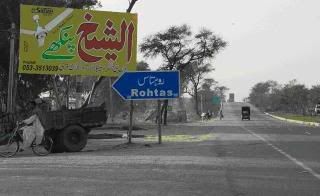 Photo to the right is the Rohtas signboard on the Highway N5 (G.T. Road). Al-Shiekh Pankhay (fans) billboard in the background
Photo to the right is the Rohtas signboard on the Highway N5 (G.T. Road). Al-Shiekh Pankhay (fans) billboard in the background
We passed Rawat, Mandra, Gujar Khan and Dina. Gujar Khan was of particular interest to me as I had been reading Gujar Khan daily news on the web for no reason at all. At Dina we stopped and asked for directions from two young gentlemen on a motorcycle.
I asked, “How do we get to Rohtas Fort? they replied, “Rohtas Road?”, I repeated several times getting the same reponse. I then realized that I had done the “cha” to them (I will narrate what that means in a moment). 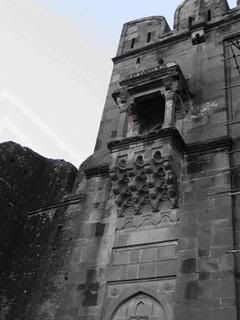 I then rephrased and asked, “Qila Rohtas?”, at which their faces lighted up and they pointed in one direction. I had totally forgotten that Rohtas Fort meant nothing to the locals. It was and will always be Qila Rohtas.
I then rephrased and asked, “Qila Rohtas?”, at which their faces lighted up and they pointed in one direction. I had totally forgotten that Rohtas Fort meant nothing to the locals. It was and will always be Qila Rohtas.
Photo to the left is Sohail Gate in Rohtas Fort: View of a Jharoka from outside with scaffolding also visible. Sohail Gate is discussed later in the article
Coming back to the “cha” comment I made earlier. This is how the story goes – I was visiting Shalimar restaurant in San Francisco- a hole in the wall serving the most delicious Pakistani food in the western hemisphere, with my good friend Yousuf Begg of Lucknow. There was a group of Europeans seated behind us. The last character in this story is the waiter who was an old man. The Europeans were struggling with the order of tea. They first tried the word “tea” and then exhausted their vocabulary when the waiter didn’t understand the request for “chai” either. Together the Europeans and the waiter looked at us for help at which Begg Sahab told the waiter to bring “cha” for the Europeans. Begg turned around coolly and resumed his dinner. The waiter repeated, “Cha” with a smile and went off. The Europeans thanked us and that’s how I saw men who had traveled the globe to meet each other get bogged down by the word chai in a small San Franciso restaurant.
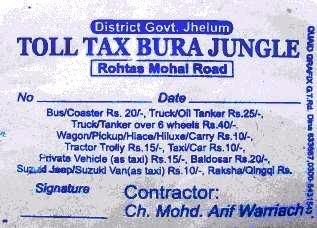 As we turned from the highway towards Rohtas a man jumped in front of our car. He was the toll man. A thekedar (conractor) belonging to district government of Jhelum. He demanded 20 rupees and insisted that all cars that were being stopped must be part of our entourage. We kept telling him that we were by ourselves and he kept asking us to make sure there weren’t any other cars that needed toll. His intention was to keep the 100 rupee note handed to him by us.
As we turned from the highway towards Rohtas a man jumped in front of our car. He was the toll man. A thekedar (conractor) belonging to district government of Jhelum. He demanded 20 rupees and insisted that all cars that were being stopped must be part of our entourage. We kept telling him that we were by ourselves and he kept asking us to make sure there weren’t any other cars that needed toll. His intention was to keep the 100 rupee note handed to him by us.
In the end he left us in a hurry running after another car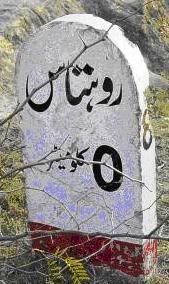 . We looked at the receipt which said Toll Tax Bura Jungle, Rohtas Mohal Road, Contractor: Ch. Mohd Arif Warraich. I stored that receipt away safely for entertainment later. Entertainment because it listed tolls for various vehicle types which included Buses/Coasters, Trucks/Oil Tankers, Wagon/Pickup/Hiace/Hilux/Carry, Private Vehicle and then Baldosar which I am assuming is referring to a bulldozer followed by Suzuki Jeep/Suzuki Van and finally Raksha/Qinggi (a Chinese contraption and a road hazard frequenting Punjab roads these days). Ch. Sahab made sure all categories, makes and models were duly listed.
. We looked at the receipt which said Toll Tax Bura Jungle, Rohtas Mohal Road, Contractor: Ch. Mohd Arif Warraich. I stored that receipt away safely for entertainment later. Entertainment because it listed tolls for various vehicle types which included Buses/Coasters, Trucks/Oil Tankers, Wagon/Pickup/Hiace/Hilux/Carry, Private Vehicle and then Baldosar which I am assuming is referring to a bulldozer followed by Suzuki Jeep/Suzuki Van and finally Raksha/Qinggi (a Chinese contraption and a road hazard frequenting Punjab roads these days). Ch. Sahab made sure all categories, makes and models were duly listed.
We finally reached the gates of Rohtas. I was thrilled at the same time a little disappointed to see its state. I will describe that shortly.
I did immerse myself in photographing this beautiful architectural treasure. I climbed many walls and terraces and found picturesque spots.
Photo to the left is the view from inside of Khwas Khani Gate of Rohtas Fort.
I then climbed a narrow and crooked stairway to find myself at the highest point of the fort where two dudes were smoking charas, enjoying the view of Tilla Jogian. They smiled at me as I surveyed the town. I smiled back as I saw rooftops, some painted and some with dish antennas. I wondered, what has become of this once grand fort?
I photographed the fort to my hearts content as Rahat waited patiently and then quietly slipped away to offer his submission and thanks to Allah almighty in the towns tiny mosque. I followed him and took photographs inside the mosque. As I was walking towards the mosque I passed the Rohtas primary school and took a photograph of a board displaying Rohtas ki kahani, us ki apni zubani. It was a shameless exhibition of self projection by the zila nazim of 2004 in the garb of a story being told by the fort itself. I found it quite childish and vulgar.
Rohtas Fort is situated about 120 km from Islamabad.
Photo to the right is the view from outside Sohail Gate.
Rohtas Fort is 16 km north west of Jhelum and 6 km from Dina. From the main highway N5 its another 8 km to this mini fortified city. This massive and monumental fort has a perimeter of approx 4-5 km. It was primarily built to keep Emperor Humayun away from his kingdom after he was defeated by Sher Shah Suri in 1539-1540. It was supposed to block Humayun’s path from Peshawar to Lahore. The Ghakkar tribes living in an around the area were also kept at bay by this massive fort. Ghakkars were loyal to Humayun and caused considerable hardship and delays in the construction of this fort but Sher Shah was adamant. He offered the locals a rupiyah for every stone they would carry to the construction site. That explains the exorbitant cost of building this fort but also highlights Sher Shah’s determination. The forts walls are terraced into 2-3 layers at places, 35-40 feet thick and upto 50-60 feet high.
Today its home to the people of Rohtas and contains a small town with a school, a mosque and many homes. The inhabitants of this town have obviously defaced and damaged the original structure of this fort in many places in addition to making mazars in nooks and crannies of it’s walls. I counted atleast 5. Some of them were built in shelters built in the walls for soldiers. One is built right at the main entrance and is shamefully colored in green paint and white choona. The only shrine that I could find a historical reference to was Shah Chandwali’s who was a saint who worked on the forts construction without taking any compensation and who in my opinion rightly deserves a shrine inside.
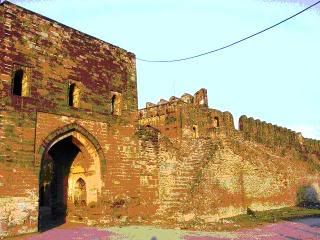 Telephone and electric lines run over the walls and a particular area with the most beautiful view of green fields of Tilla Jogian range has been converted into an open air toilet. To describe that corner of the fort would turn my stomach over.
Telephone and electric lines run over the walls and a particular area with the most beautiful view of green fields of Tilla Jogian range has been converted into an open air toilet. To describe that corner of the fort would turn my stomach over.
Photo to the right is the view from Rohtas primary school. Note telephone line pegged into the forts wall.
Tilla Jogian on the other hand is a historical place. Tilla Jogian or Hill of the Jogis is the highest peak in the salt range at 3200 ft. It has been visited by Baba Guru Nanak, Emperor Jehangir, Ranjha of the Heer Ranja folklore, Maharajah Ranjeet Singh, the warrior king of Punjab, The British Raj and finally by our very own homegrown Emperor, Mian Mohd Nawaz Sharif.
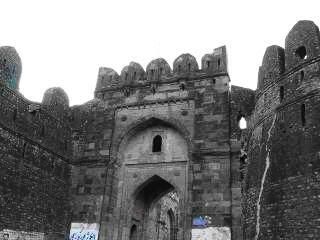 The main entrance is through the Khwas Khani gate. Khwas Khan was one of Sher Shah’s ablest generals and to honor his memory, the townsfolk have painted an advertisement right smack on it main wall selling services of a lady doctor for women and children. That’s what I call preservation Pakistani style.
The main entrance is through the Khwas Khani gate. Khwas Khan was one of Sher Shah’s ablest generals and to honor his memory, the townsfolk have painted an advertisement right smack on it main wall selling services of a lady doctor for women and children. That’s what I call preservation Pakistani style.
Photo to the left above is the Khwas Khani Gate: View from outside. Note advertisements painted on either side of the entrance.
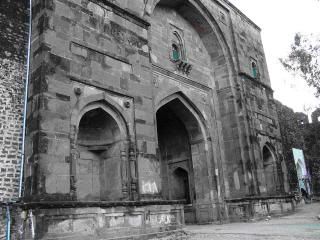 There seems to be some restoration work going on in a couple of places which was encouraging. Scaffolding was erected at the Sohail Gate and its two beautiful Jharokas were being restored, god willing, to their original splendor.
There seems to be some restoration work going on in a couple of places which was encouraging. Scaffolding was erected at the Sohail Gate and its two beautiful Jharokas were being restored, god willing, to their original splendor.
Photo to the right is the view from inside of Sohail Gate. Note metal and pvc pipes running top to bottom and a mazar in the far end of the photo. This mazar had its own private rakhwala.
A parking lot is also present inside the fort past the town where thekedars collect a parking fee of 10 rupees and another 10 rupees per person. When I asked what this money is used for the collector said he didn’t know.
There was a public toilet in the parking lot also, for ladies and gents. A board at its entrance listed a 5 rupee fee for use. The main attractions were somewhat litter free but caring citizens had managed to throw plastic bottles and orange skins wherever they could. A museum is also present but had closed by the time we reached it. A couple of pickup trucks were present and a crew was clearing up chairs and shamianas from what seemed like a venue for a party or probably a marriage.
Quite shameless in my opinion to have any kind of party in a historical place. The reason why this fort still stands strong today is because of it’s quality of construction. The outer walls are made of sandstone, lime and mortar. Places of interest inside the fort include Man Singh’s Haveli, Shahi Mosque, several gardens and wells, gallows, etc.
Haveli Man Singh: Whatever remains of it today. Notice our contribution to this historical monument. Where do we start and how many things do we fix?
As the sun was setting, a man with a stick started rounding up people like cattle telling them the area was not safe and that we will lose the right to report a mugging if we didn’t listen to him. I was at Man Singh’s haveli at the time. Man Sigh was a general in Shahenshah Jalaluddin Mohammad Akbars army. Therefore, this haveli was probably built during Akbar’s reign which lasted from 1555 to 1605. I felt brave for that reason alone. If I was near Akbar’s general, who would dare touch me. In that state of mind I told this gentleman that I was a black belt and could tackle a group of 10 people if needed. He wasn’t impressed and walked away. He took his frustration out by harassing some poor cattle that had strayed into the fort.
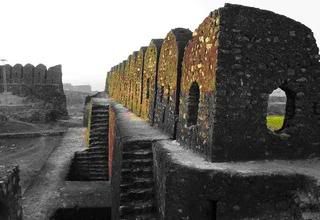 By the time we left Rohtas it was dark. My good friend and companion, the last chashm-o-chiragh of the great Lodhi kings of Afghanistan was hungry as we headed towards one of my favorite spots for dinner. We reached the Tulip hotel located at the banks of Jhelum river near the Jhelum toll booth.
By the time we left Rohtas it was dark. My good friend and companion, the last chashm-o-chiragh of the great Lodhi kings of Afghanistan was hungry as we headed towards one of my favorite spots for dinner. We reached the Tulip hotel located at the banks of Jhelum river near the Jhelum toll booth.
The place was nice, clean and uncrowded. I ordered a 96 rupee chicken tikka which I’ve never had in my life. I must admit it was unique because I was expecting “nahaya, dhoya, chaddi pehna” (in the words of the Nanna from Alif Noon) tikka since it was so expensive. It turned out to be measly and cold, which was microwaved and returned after I protested. Nevertheless the ambience was one of a kind and enjoyable.
We started our homeward journey around 8:00 pm, crossed the Jhelum toll booth and lit cigarettes. He, a Dunhill and I, a Goldleaf, ofcourse. Rest of the memory is faded as I closed my eyes and woke up near KRL officers colony on Islamabad highway….
Photo to the left is the toll booth receipt from our return journey. Exact time and place recorded.
-and now my tribute to Rahat Lodhi: every moment in the company of this gem of a man, Rahat Lodhi is priceless. He is one of the finest and most refined of gentlemen I have come across in this lifetime. I owe him something even he doesn’t remember but I never forget my benefactor. Soft spoken, well read and capable of handling life in his own dignified and respectable way, Rahat Lodhi is no less than Rohtas, monumental in character and solid like a fort.
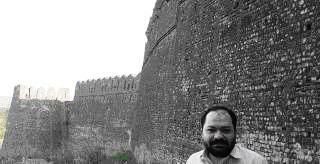 Photo to the right shows Rahat and Rohtas Fort.
Photo to the right shows Rahat and Rohtas Fort.
This visit was one the most enjoyable experiences I had in Pakistan. It made me appreciate the history of my people and their achievements. I had originally planned to dedicate this trip to the mazars of Pakistan but I could only visit one. Yet I am glad I was able to atleast visit Rohtas, it’s memory is etched in my mind. May it stand forever!
Umar Shah is a Senior Sales Engineer based in San Jose, California. He recently visited Pakistan and wrote above travelogue.
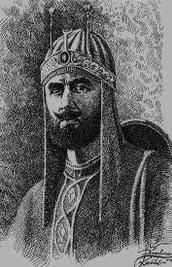
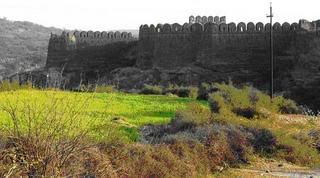

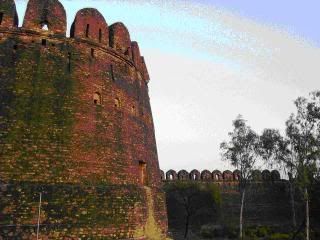


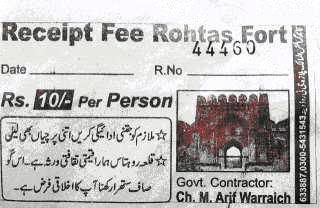
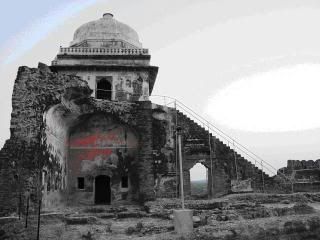
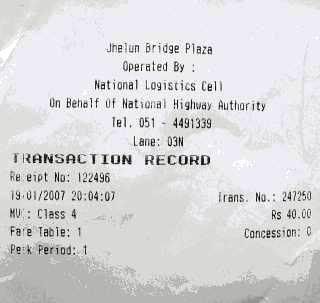



















































Dear All Things Pakistan
It was a pleasure to brows through your wonderful web site which was introduced to me by a sweet person from USA. He stayed at my home in Copenhagen during COP 15 conference and we had some enlightened discussions which refreshed my childhood memories of that unique land, we lovingly call: Our home.
The article Rohtas is a revelation. Reading it, I realized, how little we Diaspora Pakistanis know about Pakistan in all its glories.
Please keep up the good work. There are many Pakistanis who share your efforts to present a balanced picture instead of typically coloured Western media presentation.
Kind regards
Bashy Quraishy
Chair-Advisory Council-ENAR – Brussels
Chair-Jewish Muslim Co-operation Platform – Brussels
Senior Advisor – COJEP International- Strasbourg
Mobile; 0045 40 15 47 71
Phone; 0045 38 88 19 77
http://www.bashy.dk